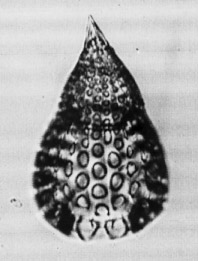 Podocyrtis
(Lampterium) fasciolata Nigrini
Podocyrtis
(Lampterium) fasciolata Nigrini Podocyrtis
(Lampterium) fasciolata Nigrini
Podocyrtis
(Lampterium) fasciolata NigriniPodocyrtis (Podocyrtis) ampla fasciolata Nigrini, 1974, p.1069, pl.1K, figs.1-2, pl.4, figs.2-3
Podocyrtis (Lampterium) fasciolata Nigrini, Sanfilippo et al., 1985, p.697, fig.30.7
Shell thick-walled, smooth. Cephalis subspherical with numerous subcircular pores, bearing a short, 3-bladed apical horn approximately the same length as the cephalis. Thorax campanulate to almost conical with subcircular pores aligned longitudinally (4 to 7 in a row) and distinct ridges between the pore rows; six to eight pores on a half-equator. Lumbar stricture distinct. Abdomen inflated, wider than thorax at its maximum breadth, narrows distally. Subcircular pores, larger than thoracic pores, usually aligned longitudinally (3 to 7 in a row) but sometimes irregular; six to eight on a half-equator. Wide poreless peristome usually with a smooth termination, but may show some thickening indicative of incipient feet. Rarely, three spathulate feet present (Nigrini, 1974).
Based on 20 specimens from the Indian Ocean. Thorax 50-83 µm long, 65-100 µm wide (usually 83-100 µm). Abdomen 83-150 µm long, 115-165 µm wide (Nigrini, 1974).
P. (L.) fasciolata differs from P. (L.) sinuosa in not having the pronounced abdominal ribs and well developed shovel-shaped feet of the latter. From P. (Podocyrtoges) ampla it differs in its smaller size - total length (excluding horn) 165-250 µm (usually 200-230 µm); maximum width of abdomen 105-175 µm (usually 115-160 µm); thoracic length 80-100 µm - and shorter horn commonly bladed (Sanfilippo et al., 1985).
Measurements given by Sanfilippo et al., 1985 show a broader range than those reported by Nigrini (1974). Probably this is because Nigrini was measuring only Indian Ocean material whereas Sanfilippo et al. included material from the Pacific, Atlantic and Caribbean and from a longer stratigraphic range.
The campanulate to conical thorax has pores aligned in longitudinal rows and separated by more or less pronounced ridges. Lumbar stricture moderately distinct. The inflated abdomen has large pores of variable size (6-10 pores on a half-equator), sometimes irregularly arranged and sometimes in longitudinal rows with very vague ridges between them. These pores, in well preserved specimens, tend to be subdivided by an internal, fine, irregular meshwork. When the pores are irregularly arranged, the outline of the abdomen is rough. The wide, pore less peristome is usually smooth and thick, but may rarely have indications of three spathulate feet (Sanfilippo et al., 1985).
P. (L.) fasciolata has a short range in the middle middle Eocene and has been found in the Gulf of Aden at DSDP Pacific Site 40, in the Gulf of Mexico and in the Caribbean. Its morphotypic first appearance lies within the Podocyrtis ampla Zone. Its morphotypic last appearance lies within the Podocyrtis mitra Zone.
Instead of being a geographic variant of P. (Podocyrtoges) ampla (Nigrini, 1974, p.1069), this form is now considered to be an off-shoot of the lineage from P. (L.) sinuosa to P. (L.) mitra. For this reason it is elevated to species rank and placed in the subgenus Podocyrtis (Lampterium). At the time of its acme, P. (L.) fasciolata far outnumbers the co-occurring P. (L.) sinuosa.
Additional illustrations can be found in Riedel and Sanfilippo, 1973, pl.4, figs.1-3.